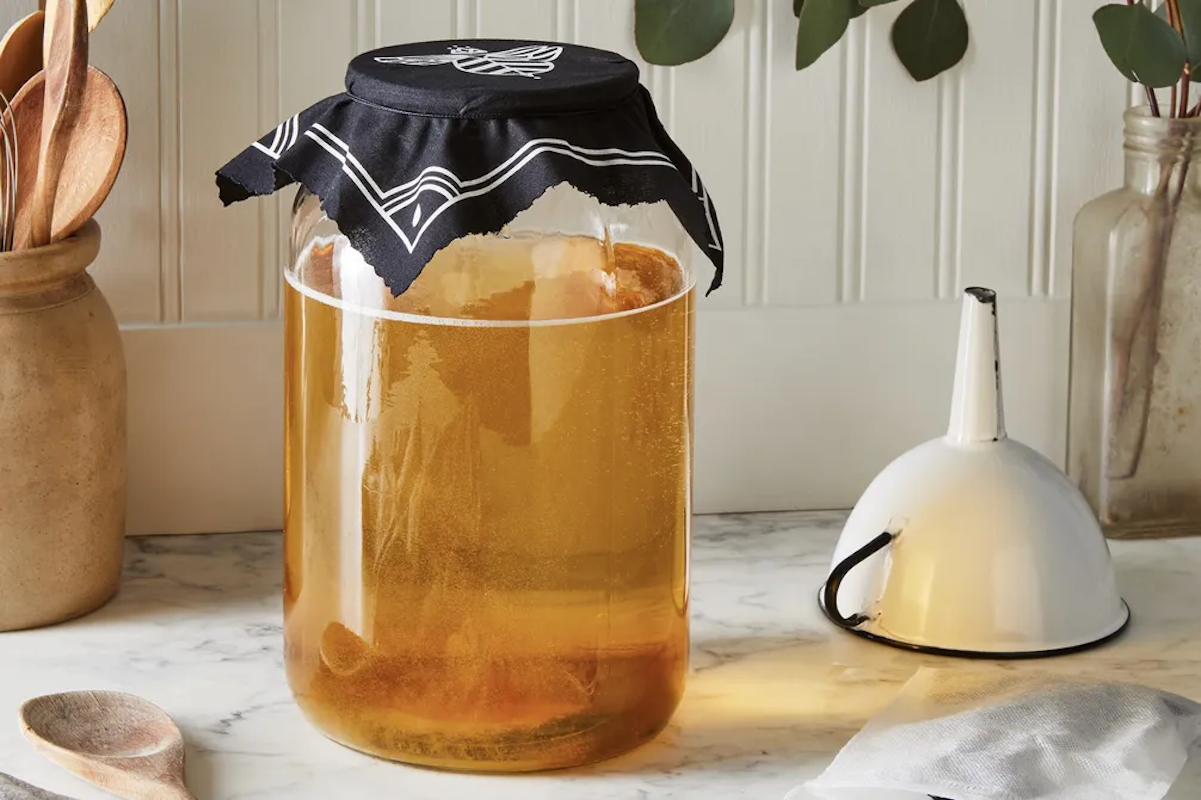I went from questioning kombucha, to loving kombucha, to brewing my own kombucha — with a few road bumps along the way.
Fear is born from ignorance, and before I understood what kombucha is or how it’s made, I was skeptical — if not terrified — not just of making it, but trying it.
At over four dollars a bottle at the grocery store, and more at the local corner bodega (do you know how many heirloom tomatoes that can buy?!), kombucha had never been something I was tempted to splurge on. I thought of it as a drink that was, mysteriously, appealing to both hippies and socialites. It often involved chia seeds, and I was absolutely not interested in that. Moreover, my friend Rebecca was brewing her own, and her SCOBY — the whiteish liver-like mass that is the yeast and bacteria “mother” of the fermented tea — looked more like an exhibit in a museum of medical mysteries than something that belongs in a beverage.
But when I finally decided to taste kombucha, I understood the fuss: With its sharply sweet vinegary flavor, kombucha is everything tart and delicious about shrubs but more sippable — and fizzy! (There are lots of purported probiotic health benefits, too, but I was less interested in that aspect and more interested in an improved taste, in saving money, and in having a pet project of my own.)
I decided to go the DIY route and make my own kombucha at the Food52 offices. I was scared at first. Actually — fueled by my uncertainty about what to expect — I was scared throughout most of the process. And since I was embarking on a new project in front of my colleagues, the endeavor was particularly high-pressure. The editorial team watched me tear up when I had to throw away an entire SCOBY due to fly infestation; they dealt with my frantic text messages and emails, my constant sighing and head scratching.
Was it worth it in the end? Yes. Not only for the bottles of kombucha in the refrigerator (which, for the record, taste much better than even the fanciest store-bought varieties), but for the feeling of accomplishment. This became “Sarah’s project” at the office — my legacy. Evidenced by the length of this post, I clearly learned more than I expected, including a whole new lexicon of words and phrases like “‘buch,” “starter,” and “second fermentation.”
If you start searching for information on making kombucha, you might find yourself going down a rabbit hole. Hey, maybe you’ll see me down there! There are a million ways to brew kombucha and a million tips for how to get the healthiest, tastiest brew possible. I’m going to explain what worked (and didn’t work!) for me, but I’m sure I’ll be experimenting and refining in the future.
***
A few basics before you embark:
- Kombucha is fermented tea with a history that dates back thousands of years. It’s made by adding a SCOBY (a symbiotic colony of yeast and bacteria — similar to the vinegar “mother”) to sweetened tea.
- Be prepared to spend some time and make an initial investment on this project. You’re in it for the long haul: Depending on the length of your fermentations, your first batch of kombucha will take around 1 1/2 to 2 weeks from starting to enjoying. And once you’ve started, you’ll (hopefully) have a viable SCOBY, which means you’ll want to start a new batch each time you’ve finished up the current one. Although none of the items or ingredients you’ll need for kombucha are prohibitively expensive, you will need to buy the proper jars, along with tea, sugar, and tea towels.
- And, most importantly, you’ll either need to obtain a SCOBY from a source you trust — be it a reputable website or a kombucha-brewing friend — or make your own (instructions below!). Our SCOBY, which we named “SCOBY Doo,” came in the mail from the home of my good friend Rebecca in Cleveland, along with her instructions for brewing (pictured below), which I followed to the letter. I recommend brewing with a friend, so that you can ask them as many questions as possible at all hours of the day. I can be this friend. (I might even send you a SCOBY!)
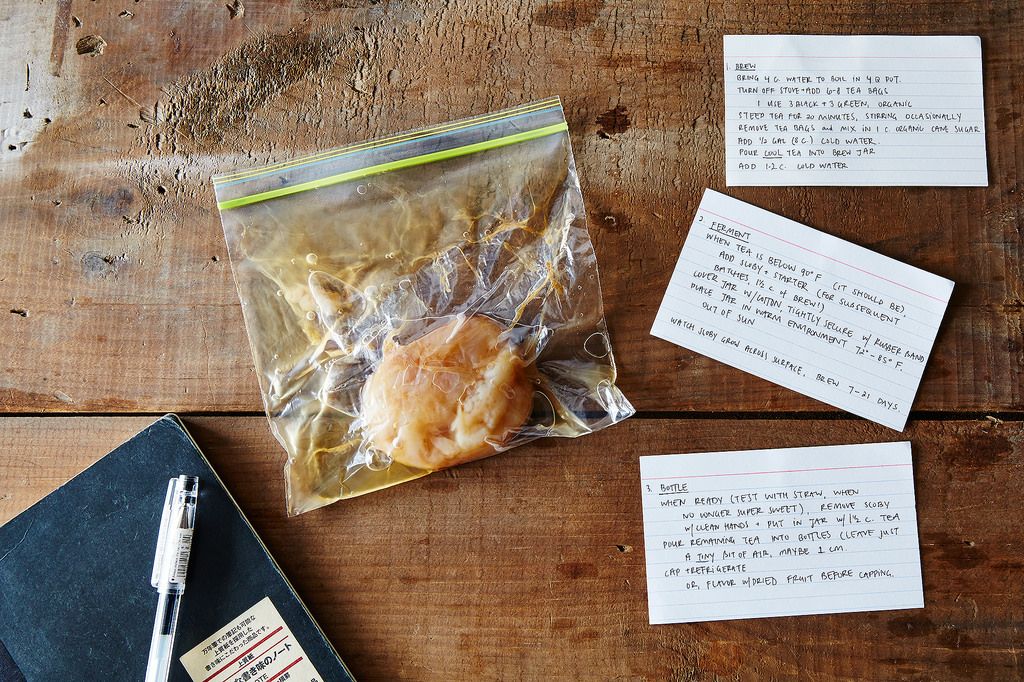
* * *
Here’s how to make a SCOBY from scratch:
If you didn’t buy one online or inherit it from a friend, never fear — you can make your own:
1. Gather together your ingredients and tools: 7 cups of water; 1/2 cup of cane sugar; 4 bags of black tea (or 1 tablespoon of loose leaf tea, though the teabags work best and you won’t have to strain the tea when it’s done); 1 cup of plain unpasteurized store-bought kombucha (ideally with the little tangly bits of SCOBY floating around at the bottom of the bottle); a large, extremely clean and dry wide-mouth canning jar; a thin, clean, tightly-woven piece of fabric or tea towel (but not cheesecloth — more on this below); and a few sturdy rubber bands.
2. Make the sweet tea by steeping the tea bags in boiling water for 20 minutes (or longer) and completely dissolving the sugar. Let the tea cool completely to below 90°F (or roughly room temp) and pour into a big canning jar. Otherwise, the cultures in your SCOBY to-be might be harmed or killed by the heat.
3. Next, pour the cup of prepared kombucha (bits of SCOBY and all — that’ll help along your SCOBY to-be) into the canning jar and cover with the piece of fabric, then secure with a rubber band or two.
4. Store your covered jar in a room-temperature area that’s out of direct sunlight. It helps to put it in a hard-to-reach kitchen cupboard that won’t get much traffic for a few weeks.
You’ll keep the jar there for two to four weeks, checking the SCOBY every few days until bubbles form on the surface of the tea, a thin, whiteish, jelly-like film forms across the top of the liquid, and the film becomes almost fully opaque in color. The SCOBY is ready when it’s grown into a 1/4-inch-thick puck. If you see bubbles forming at the top of the liquid throughout the process, especially in the later stages of SCOBY-formation, that’s a good sign of carbon dioxide development, indicating that your SCOBY’s a healthy fermentor.
5. Your SCOBY is now ready to be used in your first batch of kombucha!
***
Kombucha glossary
Throughout this guide to making kombucha, there are a few keywords that you’ll commonly hear.
Carbonation
Part of what makes kombucha so fun to drink is that it’s bubbly, thanks to carbonation. Surely you’re familiar with the term carbonation when you picture soft drinks or sparkling water, but what should you expect from carbonation in kombucha? The air bubbles in kombucha are a result of the live cultures used to make it. As sugar is added to the beverage, the cultures eat it (because sugar is tasty and who doesn’t want to eat it). This causes a chemical reaction that produces carbon dioxide, thus creating carbonation.
Fermentation
Kombucha is just one of many fermented food and beverage products: Think yogurt, sauerkraut, pickles, and other gut-beneficial edibles. “Kombucha is sugar-sweetened tea fermented by a community of organisms into a delicious sour tonic beverage, sometimes compared to sparkling apple cider,” writes Sandor Ellix Katz in his book, “The Art of Fermentation.”
SCOBY
I’ve said it before but I’ll reiterate it here in my mini-kombucha dictionary: SCOBY stands for “symbiotic culture of bacteria and yeast” and is an essential ingredient used in the fermentation process for kombucha. SCOBY is a key player, but what it is not is cute. Picture a rubbery flat disc. That’s SCOBY. It’s dense and opaque and smells like vinegar. Even kombucha-lovers will be a little skeeved out by SCOBY, but it’s all part of the process.
Starter tea
Starter tea is kombucha! It’s kombucha used to make more kombucha. As long as your kombucha has live, active cultures in it, it’s usable for a new batch. If you drank all of your homemade kombucha (because why wouldn’t you), you can also use store-bought kombucha. In a few paragraphs, I talk about using a combination of SCOBY and store-bought kombucha to make my own.
* * *
Here’s how to make your first batch of kombucha:
The first steps are very simple — brewing, sweetening, and cooling tea.
1. Bring 4 cups of water to a boil in a 4-quart pot. Turn off the heat and add 6 to 8 tea bags. Steep for 20 minutes, stirring occasionally.
- I didn’t use organic tea, and instead of loose tea — which might be easier to guarantee is high-quality — I went with a mixture of black and green tea bags.
- I even used a couple bags of Earl Grey when I was running low on other options. That worked, too!
- Herbal teas cannot be made into kombucha, but I am excited to experiment with oolong and caffeine-free rooibos — both of which work as base teas — in the future. There’s a lot of information available on all the different types of teas that can (and can’t) be used for brewing kombucha. I’ll read up for my future batches.
- I didn’t use water that had been purified in any way and I didn’t see negative consequences. You’ll see resources online that will advise against using tap water, but I didn’t notice harmful effects.
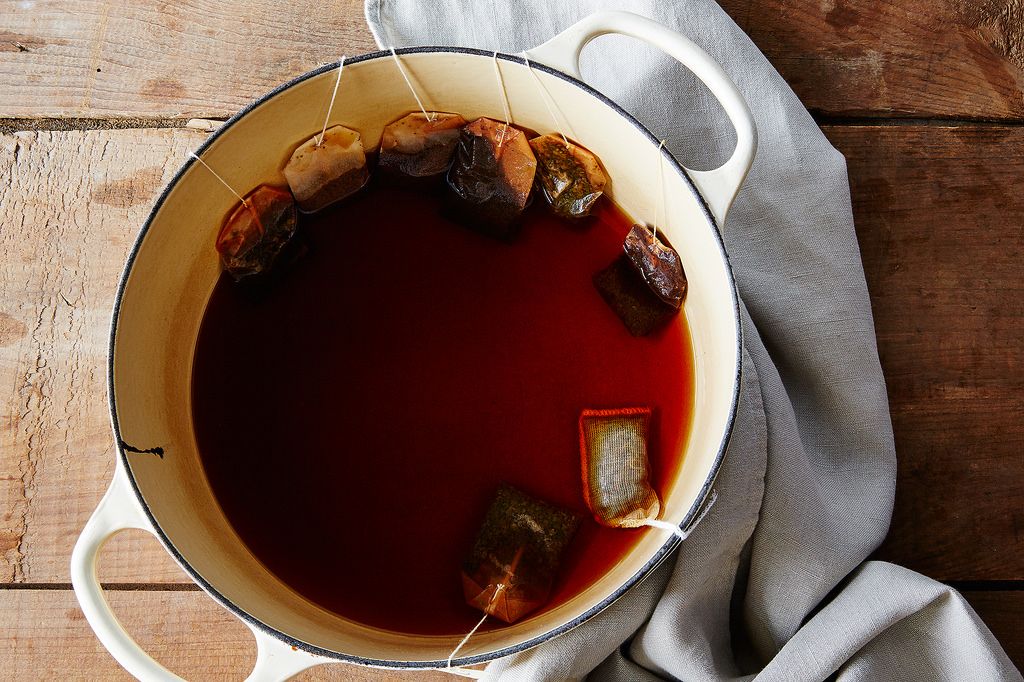
2. Remove the tea bags and add 1 cup of organic cane sugar and a half-gallon (8 cups) of cold water. Stir to dissolve the sugar granules.
- I used organic cane sugar and turbinado sugar. Both worked, but finer sugar will dissolve more easily into the tea.
- If you want to explore using other sweeteners — like brown sugar, honey, or agave — I’d recommend first referring to this chart, as some sugars are harder to work with than others.
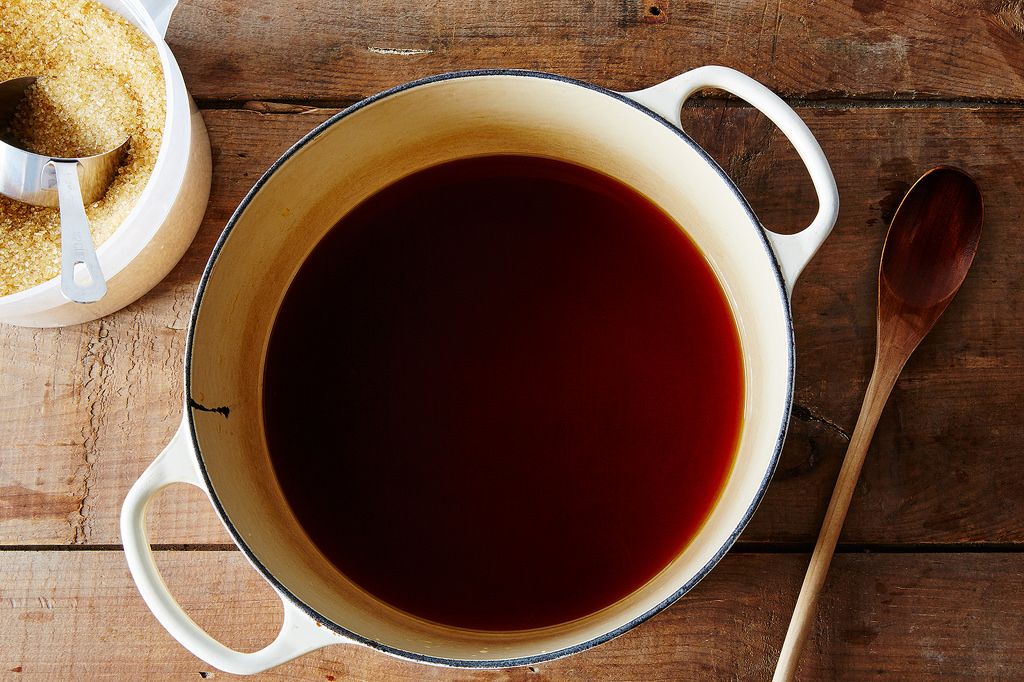
3. Pour the cool tea into a glass brew jar (the biggest jar you can find — a 2- to 3-gallon jar is best), then add 1 to 2 cups of cold water. It’s important that your tea be close to room temperature by the time you add the SCOBY — warm tea might harm it.
- In addition to glass, you can also use ceramic, stainless steel, or wood.
- Many resources will tell you not to clean your jar with soap, as it could harm the SCOBY. I did clean with soap, but I made sure to rinse very thoroughly before adding the tea. If you do not want to use soap, you can sanitize the jar (and any other equipment) with white vinegar and hot water.
- Use a wide-mouth jar: It’s better for air circulation and it will make it easier to remove the SCOBY later on.
4. When the tea is below 90°F (which it almost surely will be at this point), pour in the SCOBY and 1 1/2 to 2 cups of the starter liquid that the SCOBY arrived with (or, if this is your second time around, that the SCOBY was stored in after you bottled the brew).
- If your SCOBY didn’t come with enough liquid, you can supplement with plain/original-flavored store-bought kombucha (or leftover liquid from your homemade SCOBY). The first time I brewed, I used the liquid that the SCOBY came with as well as 1 1/2 cups of Health Ade Original Kombucha because I was nervous. The SCOBY seemed to grow very quickly with the help of the starter liquid.
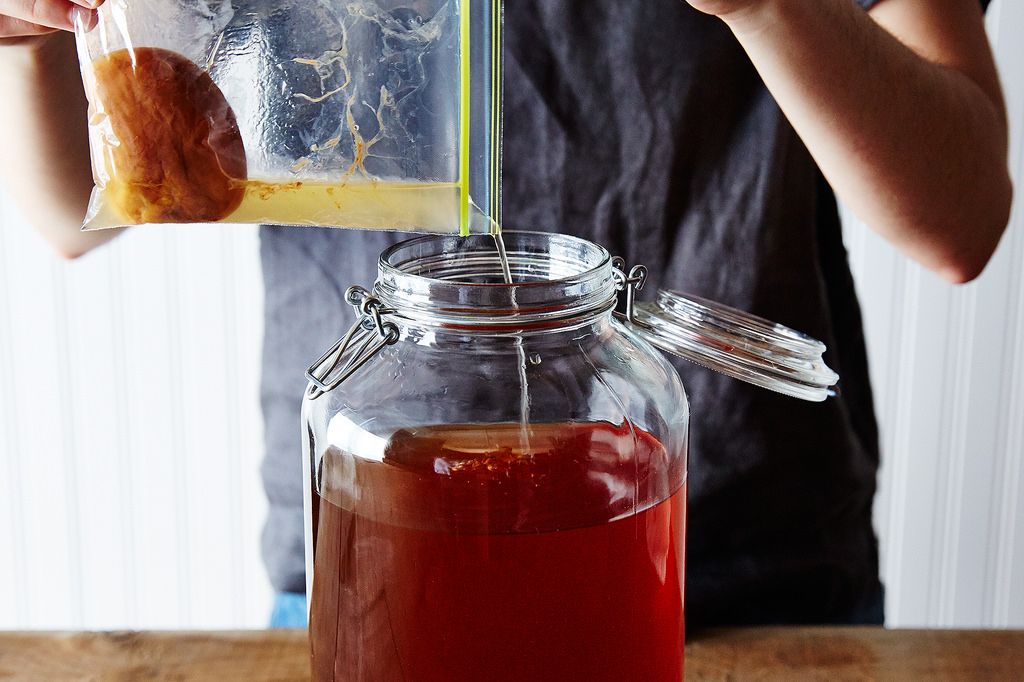
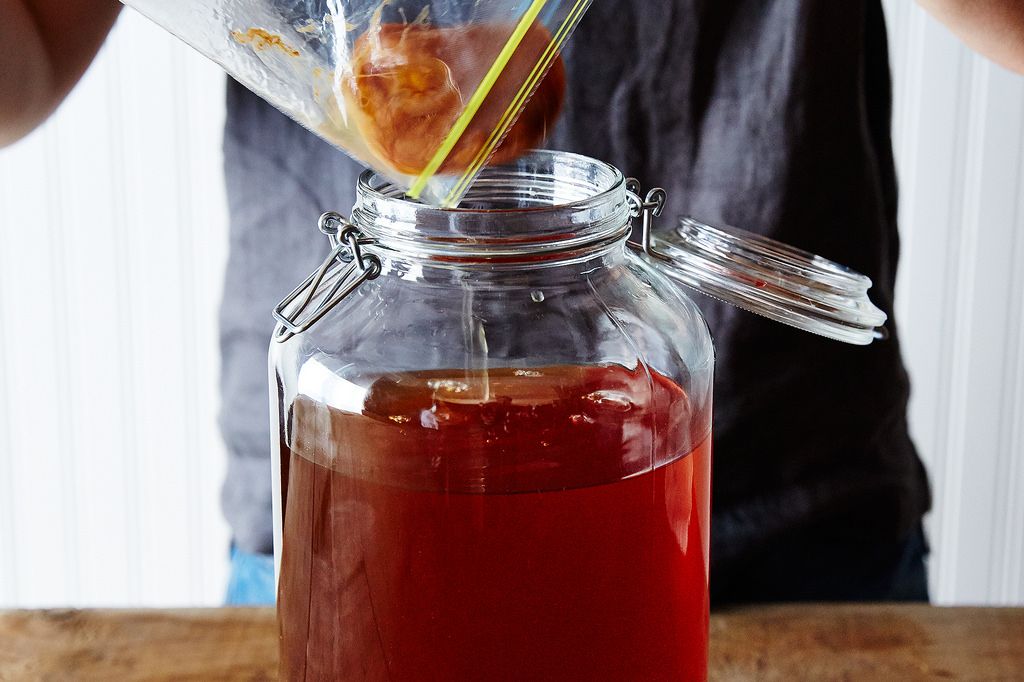
Here comes the more nerve-wracking, nail-biting, and, ironically, hands-off part of the procedure!
5. Now that your SCOBY is in the tea, you have to cover the jar so that the precious SCOBY is neither vulnerable to contamination nor suffocation.
- Rule #1: Do not, under any circumstances, use cheesecloth. With our first SCOBY, I secured two layers of fine cheesecloth over the top of the jar with rubber bands. Everything seemed fine; the SCOBY grew across the top of the tea nicely, forming a thick layer, and the whole jar gave off a sweet, vinegary scent.
The first time I unwrapped the cheesecloth to taste the brew, however, I noticed a fruit fly flit from the direction of the jar. I convinced myself that it had just come from somewhere nearby. The next day, I pulled back the cheesecloth and another fly emerged, straight from the SCOBY this time. When I examined the SCOBY surface, I saw squirming, the signs of fly larvae. The whole SCOBY had to be tossed, I cried, and Rebecca sent another one in the mail. (We named this second SCOBY “SCOBY Doo II,” and this is the SCOBY modeling in the photos.)
- Fruit flies, as I learned firsthand, are the most common contaminants of kombucha, and you might see them circling your brew like evil vultures, eager to poison your SCOBY. To prevent flies, use a tea towel — or an old (but clean!) T-shirt — held in place by several sturdy rubber bands. The tea towel is woven much more tightly than cheesecloth and will therefore be more effective at keeping out flies. Store your jar in an environment that’s as fly-free as possible (not near the bowl of ripening stone fruit, for example). I kept the kombucha at the editorial desk, where I could act as a monitor, shooing flies away on the regular.
6. Wait and watch. Once your SCOBY is in the sweetened tea — shrouded comfortably with a tea towel and living in a location that’s under 90° F with good air circulation and little direct sunlight — it will be 1 to 4 weeks until it’s ready to drink.
- You’ll watch the SCOBY grow into a thick, leathery, white mass across the surface of the tea.
- You also might notice some discolored spots (which you can see in the top-right photo below). When I noticed these dark spots, I had a panic attack. Mold is the second serious threat to your SCOBY.
- Fortunately, it’s not that difficult to distinguish mold from natural dark spots (which result from normal dying yeast cultures). Mold will look like the green, fuzzy stuff you find on aging bread and cheese rather than brown strands or masses. If you suspect mold, you’ll have to throw out your SCOBY and start again.
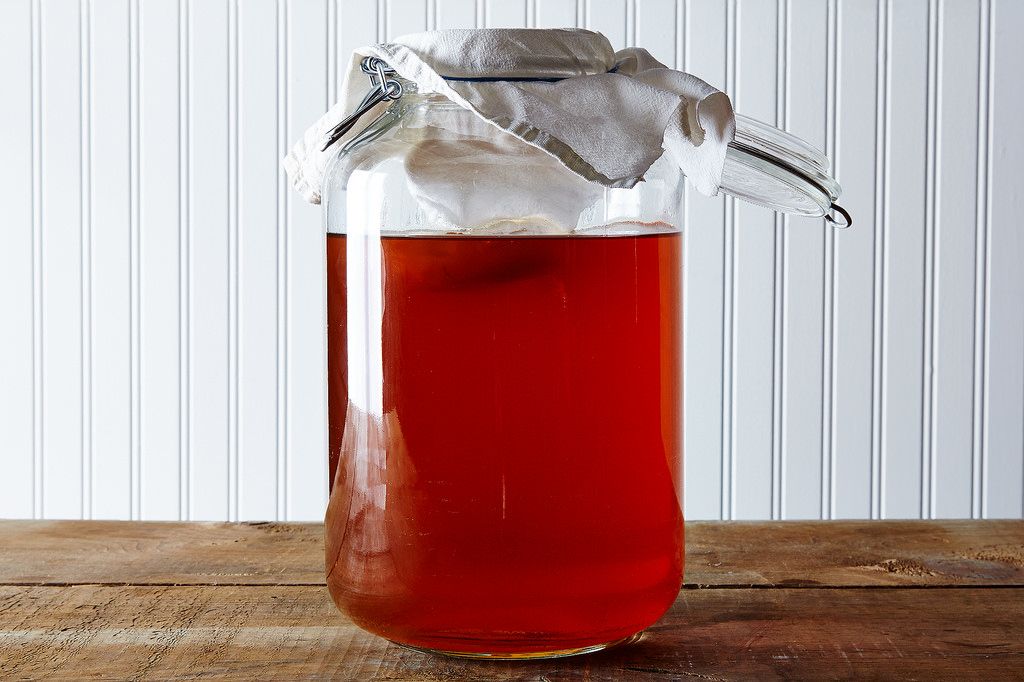
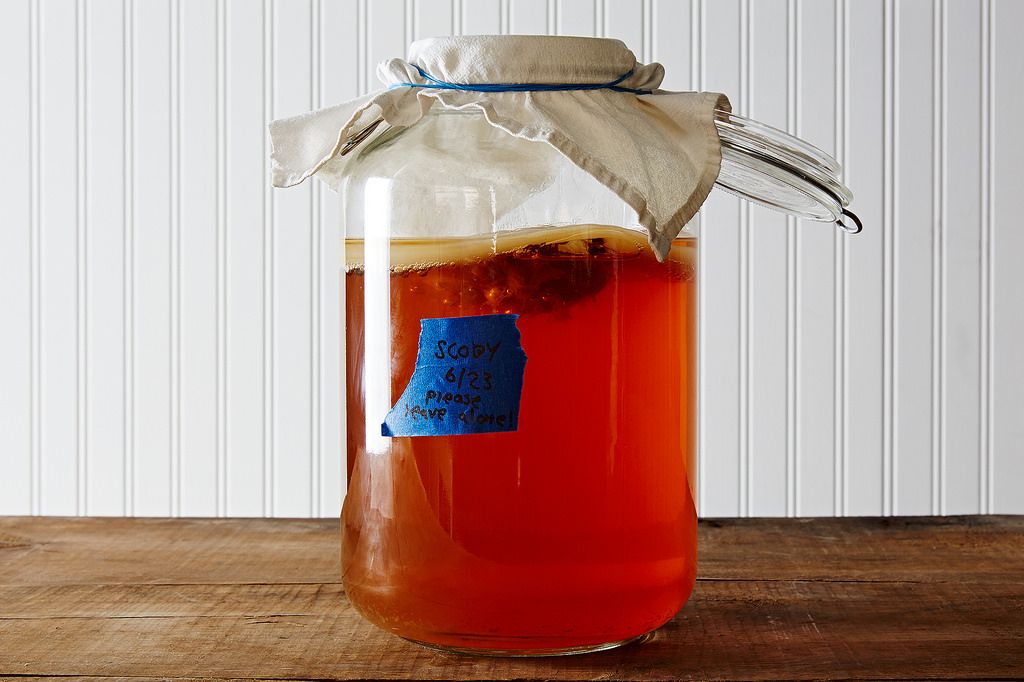
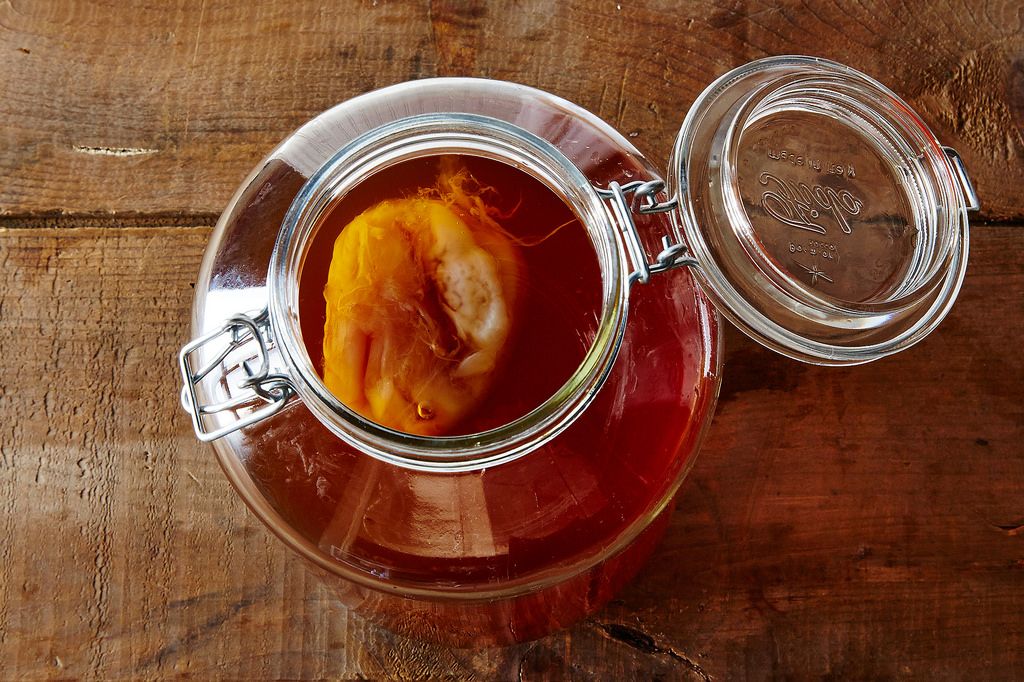

The two images on the left show the SCOBY once it was first placed in the brew jar. The two images on the right were taken 10 days later, once the SCOBY had grown across the top of the tea.
7. After one week, gently push the SCOBY aside with a straw and take a sip of the liquid. If it’s as tart as you’d like, you’re ready to proceed to the next step. If you want kombucha that is sharper and more vinegary, allow the tea to ferment for more time.
- I found that I liked how our kombucha tasted after 10 days of fermentation.
8. When you’re happy with the flavor, move the SCOBY to another large jar with 1 1/2 to 2 cups of the brewing liquid (this will be the SCOBY’s home, and you’ll use that liquid to start the next batch). Cover with a tea towel and rubber bands, just as you did before, and set aside.
- Now you’re wondering what to do with this SCOBY. The next logical step is to start another brew! Make more tea, then use that SCOBY in your second batch of kombucha — that’s the only road I’ve taken so far.
- You can also separate the SCOBY layers and give one to a friend. It might not be what your friends wants for his birthday, but he’ll surely appreciate it, right? You’ll want to make sure that you gift the SCOBY with enough of the brewed tea so that it will survive and so that your friend has a starter for step #4. Be sure to bug your friend to make the kombucha as soon as he can.
- I don’t have any experience storing SCOBYs, but “The Noma Guide to Fermentation” recommends storing the extras in an open-top jar, submerged in twice its weight of kombucha or 20% sugar syrup (800 grams water and 200 grams sugar, brought to a boil, then cooled), where they will go into a dormant state. You’ll have to change the syrup or storage-kombucha every 2 to 3 weeks. You can also keep your SCOBY in the fridge to slow its metabolism, but then when you want to start brewing again, your SCOBY might be sluggish for the first few cycles (meaning that it might take some extra fermenting time to achieve the flavor you’re looking for). Learn more about taking a break from brewing here.
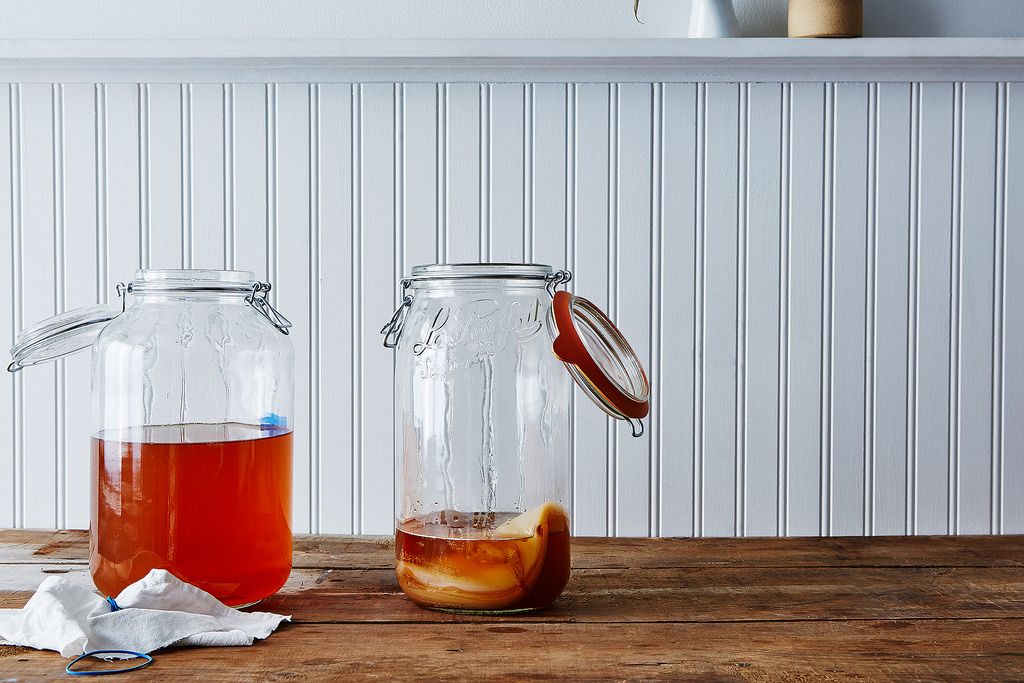
9. Now collect bottles. These should be glass bottles with plastic tops, such as old kombucha bottles or flip-top brew bottles. When the tea is transferred to smaller bottles, it enters a second fermentation and becomes “drier” (less sweet) and — this is fun — carbonated.
- It’s important not to use any bottles with metal tops in order to prevent the chance of any reaction between the kombucha and the metal. If you want to use Ball jars, you’ll need to get plastic tops to cover them.
- I also tried one glass-topped Weck jar, but it wasn’t sufficiently airtight.
- To gauge the cabonation levels in the bottles, I used one plastic bottle, as well. The plastic bottle is your guide to carbonation: It becomes increasingly solid and pressurized as the kombucha ferments; when it’s rock-solid, that’s an indication that the tea in the glass bottles will be bubbly.
10. Once you have several suitable empty bottles, you’ll also want to think about flavors. Thrilled that the kombucha was fly-free, mold-free, and good-tasting, I was happy to leave it as is. But my colleagues helped me realize how fun it can be to play with flavors.
It’s important to remember not to go too crazy with the add-ins: Introducing additional sugar in the form of fruit or fruit juice during this second ferment might result in too much pressure build-up and a consequent explosion.
Here are the flavors I’ve tried so far:
- Hibiscus: three or four dried flowers
- Grapefruit: about 2 tablespoons of grapefruit juice, with the pulp; this was delicious, though you will see online that many suggest using juice with no pulp to reduce the number of stringy bits that will be in the finished product
- Ginger: a 1-inch piece, cut into matchsticks
- Rhubarb lime: lime zest and diced rhubarb; too tart for my taste
- Blueberry lavender: about 1 teaspoon dried lavender and 2 or 3 frozen blueberries
- Rose petal: about 1/2 tablespoon of dried rose petals
- Orange saffron: a pinch of saffron and a strip of orange peel
- Cherry and jalapeño: an unseeded jalapeño half (cut lengthwise) and a few tablespoons of tart cherry juice concentrate
11. Add your flavorings of choice to the bottles, then use a plastic funnel to pour the tea over top. You’ll want to fill your bottles almost to the very top (in the picture below, I didn’t fill the bottles high enough). The fuller your bottles are, the more carbonated they will become. If you see your bottles are vigorously bubbling, you can “burp” them by opening the tops to release a bit of pressure.
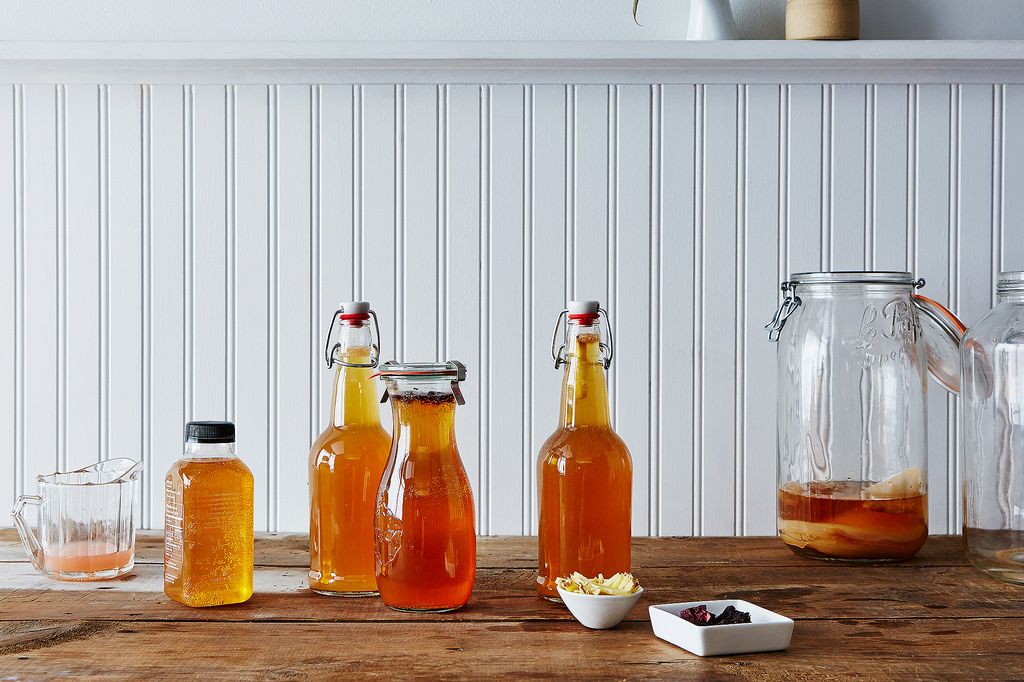
12. Once the plastic bottle is very firm — this took about 3 days for us — move all of the bottles to the fridge, where they’ll stop gaining fizz. (I prefer to err on the side of caution, so I was eager to refrigerate the bottles sooner rather than later.)
When you’re ready to drink the kombucha, open a bottle under a bowl or in the sink to avoid getting soaked from over-active carbonation. If you’re going to be unappetized by strands of SCOBY and bits of your flavorings (or if you’re serving this to people who have never tried kombucha before), you can strain the drink through a fine sieve to get a more homogenous beverage.
 From left to right: hibiscus, grapefruit, and ginger kombucha.
From left to right: hibiscus, grapefruit, and ginger kombucha.
Need more kombucha information? Here are the resources I found most helpful:
- How to Make Kombucha (Food Renegade)
- Choosing Ingredients for Making Kombucha (Cultures for Health)
- Tea and Kombucha: What to Use and What to Avoid (Kombucha Kamp)
- How to Bottle Kombucha Tea (Whole Lifestyle Nutrition)
- How to Increase Carbonation (Kombucha Kamp)
- Making Fizzy, Fruity Kombucha: The Second Fermentation (Nourishing Days)
- How to Flavor Homemade Kombucha Tea (YumUniverse)
- How to Make Your Own Kombucha SCOBY (The Kitchn)
- How to Make Kombucha Tea at Home (The Kitchn)
- “The Noma Guide to Fermentation“
Photos by James Ransom and Bobbi Lin
